





Black Vulture |
Turkey Vulture |
|---|---|
Standing Posture |
|
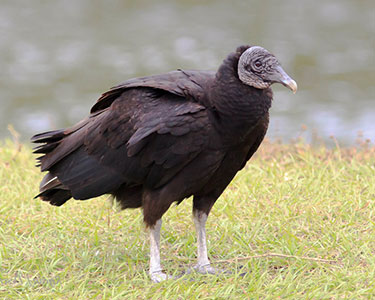
[Image of Black Vulture standing]. (n.d.). 6 Simple Steps to tell a Turkey Vulture from a Black Vulture. https://avianreport.com/ 6-simple-steps-to-tell-a-turkey-vulture-from-a-black-vulture/ |
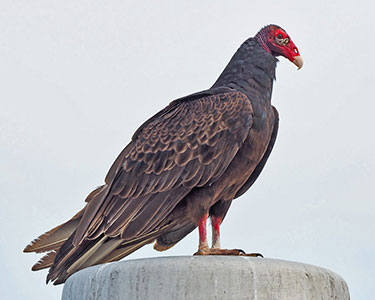
[Image of Turkey Vulture standing]. (n.d.). 6 Simple Steps to tell a Turkey Vulture from a Black Vulture. https://avianreport.com/ 6-simple-steps-to-tell-a-turkey-vulture-from-a-black-vulture/ |
|
The plumage is entirely black; the tail is very short and usually covered by the bird's folded wings. The legs are blackish-brown but appear off-white because vultures have the habit of defecating on their own legs, creating an excrement coating. The reason behind this is to help the birds cool off and also to get rid of some of the acidic build up in their stomach, due to their highly concentrated stomach acid. |
The plumage is overall dark brown and has feathers with lighter edges. The tail is longer but is concealed by the bird's long folded wings. The legs are red but often look whitish because of excrement coating. This happens for the same reason as the Black Vultures: cooling down and acidic waste disposal. This habit of defecating on legs to cool down is called Urohidrosis, and is common among storks as well as vultures and condors. |
Head |
|
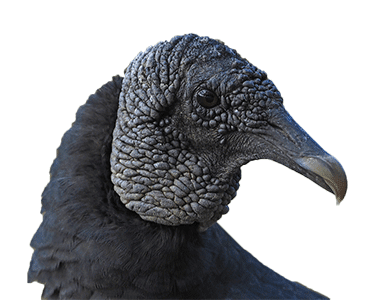
[Close-up of Black Vulture head]. (n.d.). 6 Simple Steps to tell a Turkey Vulture from a Black Vulture. https://avianreport.com/ 6-simple-steps-to-tell-a-turkey-vulture-from-a-black-vulture/ |
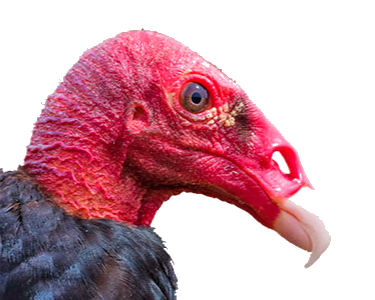
Close-up of Turkey Vulture head [Photograph]. (n.d.). 6 Simple Steps to tell a Turkey Vulture from a Black Vulture. https://avianreport.com/ 6-simple-steps-to-tell-a-turkey-vulture-from-a-black-vulture/ |
|
The head and throat are dark-grey with densely folded skin. The bill is thin and relatively longer than that of their counterpart; the Turkey Vulture. The bill is black with a lighter tip, and the nostrils are too small to be noticeable. Immature birds have a dark black rather than grey head. |
The head is red with folded skin. The intensity of the red color and pattern varies among individuals of certain ages and areas. The bill is pure white with a sharp hook. The Turkey Vulture's perforate nostrils are very visible, and look like a hole in their head. Immature birds have a dark head, which turns red as they become adults. |
Flying |
|
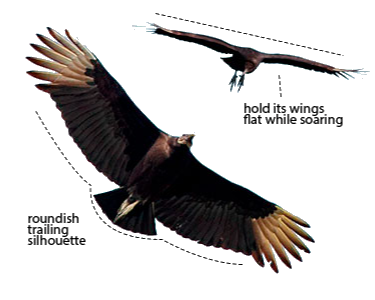
[Diagram of Black Vulture flight]. (n.d.). 6 Simple Steps to tell a Turkey Vulture from a Black Vulture. https://avianreport.com/ 6-simple-steps-to-tell-a-turkey-vulture-from-a-black-vulture/ |
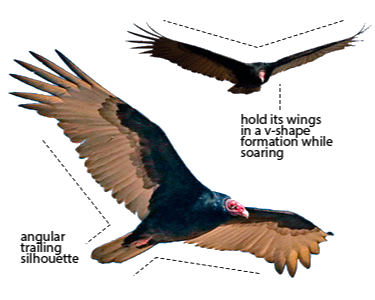
[Diagram of Turkey Vulture flight]. (n.d.). 6 Simple Steps to tell a Turkey Vulture from a Black Vulture. https://avianreport.com/ 6-simple-steps-to-tell-a-turkey-vulture-from-a-black-vulture/ |
|
The broad wings and short tail give the impression of having a roundish trailing edge silhouette. The white feathers on the edges are called 'fingers' and are probably the most distinguishable feature of the Black Vulture in flight. The bird is more likely to be seen beating its wings and holding them in a flat formation while soaring. Wingbeats are quick and snappy. |
The long and narrow wings are well separated from the long and stubby tail. The Turkey Vulture seldom beats its wings, and soars with an unsteady but graceful teetering motion. Its feet, during flight, are far from the tip of the tail. The Turkey Vulture holds its wings in a shallow V-formation while soaring. |
Wings Spread |
|
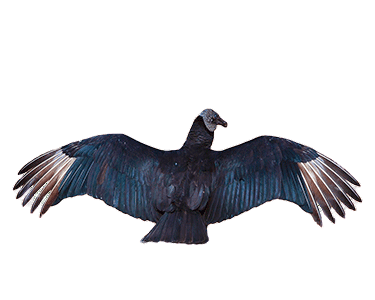
[Black Vulture wings]. (n.d.). 6 Simple Steps to tell a Turkey Vulture from a Black Vulture. https://avianreport.com/ 6-simple-steps-to-tell-a-turkey-vulture-from-a-black-vulture/ |
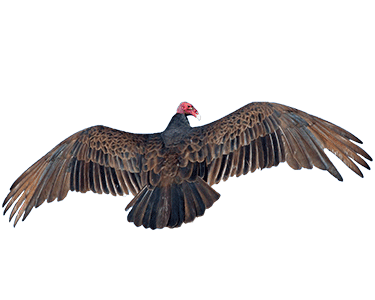
[Turkey Vulture wings]. (n.d.). 6 Simple Steps to tell a Turkey Vulture from a Black Vulture. https://avianreport.com/ 6-simple-steps-to-tell-a-turkey-vulture-from-a-black-vulture/ |
|
Both Black and Turkey Vultures normally spread their wings out in this posture on the morning perches facing away from the sun. Birds adopt this posture while the sun is rising and normally lasts from only a few seconds to 15 minutes. Vultures also adopt the spread-wing posture during the rain. Spreading their wings in the morning is likely to help birds dry they feather from the humidity accumulated overnight. Adopting the spread-wing position during the rain is likely to replace a bath and help clean up feathers from pieces of food stuck in their plumage. The position is also likely to help the bird regulate their temperature on hot days, although the true reason is still not fully known. |
|
Measurements |
|
|
Weight: 3.3 lbs Wingspan: 53.9-59.1 in (137-150 cm) Length: 23.6-26.8 in (60-68 cm) |
Weight: 2.6-4.3 lbs Wingspan: 66.9-70.1 in (170-178 cm) Length: 25.2-31.9 in (64-81 cm) |